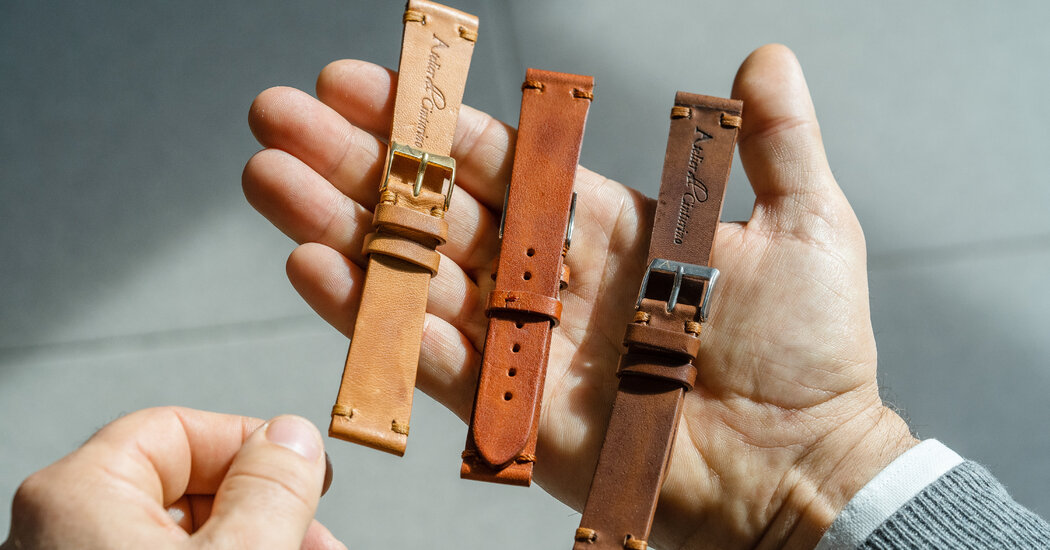
MILAN — Inside a nondescript condominium in Portello, a former industrial area northwest of the city center, a worn leather bag filled with samples had been left on a desk.
It held a navy ostrich band ready for a Jaeger-LeCoultre Reverso; alligator leathers from a farm in Mississippi that had been tanned in Italy; and strips of Tuscan calf leather, dyed by a centuries-old vegetable tanning process and finished to a waxy one-of-a-kind patina.
They are among the products and materials of Atelier del Cinturino (in English, Strap Studio) an Italian family business in leather watch straps that has bridged three generations.
Christian Zanaboni, the company’s current owner and its only employee, 51, was nearby on a recent day, fielding calls from clients and retailers. He also planned to travel to a workshop in a southern district of the city, where artisans make the company’s straps by hand (he refused to identify the shop, worried about competition).
His business produces about 2,000 straps a year, Mr. Zanaboni said, selling to about 100 retailers around Italy as well as producing bespoke straps for individual clients.
A strap is a small item, but there are dozens of elements that can be personalized: lining, design, size, stitches, tip shape, buckle, keeper, tinting, imprint and stamping — even selecting the exact part of a skin. “Sometimes I have customers who want to create a strap that’s worth more than the watch,” Mr. Zanaboni said with a laugh.
An alligator strap compatible with a 33-millimeter Cartier Ballon Bleu, for example, is priced at 160 euros, or $173.
Mr. Zanaboni said that clients currently preferred a vintage finish, suedes or perhaps contrast saddle stitching, and that some switched their watchbands to match the season. In the summer, they might opt for brighter colors like lapis blue or red.
He displayed the sample card he uses to show customers the business’s range of leathers, including alligator, shark, ostrich, llama, buffalo, kangaroo and galuchat, or sharkskin. And this being Italy, the names of the colors have mouthwatering connotations. A warm brown Tuscan leather is called castagna, or chestnut, evoking the roasted scent often smelled in northern Italy during the winter months. Then there’s a rich golden shade with the look of saffron risotto, Milan’s signature dish, and even miele, or honey.
In addition to straps, the business also produces small leather goods, like credit card cases and travel rolls for watches, and accepts commissions. (Like a sheikh’s request for a rolling suitcase, made in alligator, with a reinforced compartment to store a watch collection.)
Mr. Zanaboni routinely visits his clients’ homes to fit straps and, once they are adjusted, delivers the final product in an emerald-green velvet pouch. “It’s all a service,” he said, curtly dismissing those who “send straps without fitting them.”
He was stuffing some worn dog leads into a bag because “an important client” wanted them copied. Although he was reluctant — “this is not my business,” he said, huffing — he did intend to bring them to the workshop.
The business’s story stretches back seven decades. In 1945, Mr. Zanaboni’s paternal grandfather, Giovanni Zanaboni, opened a workshop that produced buckles and later watch straps in the basement of his villa in Arluno, about 20 miles west of Milan. And Mr. Zanaboni’s father, Giuseppe, continued the business.
Mr. Zanaboni himself, however, initially had planned to be a watch repair technician, spending three years studying at La Scuola di Orologeria del Capac in Milan and then working for Cartier. But he said he found the repair business “too solitary” and in 2014 took over the business.
A lot has changed since then.
There were 4,098 small leather businesses operating in Italy during the first six months of 2022, a significant decline from the 4,482 that were operating in 2019, according to Assopellettieri, the Italian leather goods manufacturers association. (About three-quarters of those businesses have nine or fewer employees, it said.)
Franco Gabbrielli, the association’s president, said the coronavirus pandemic contributed to many of the closures, describing the surviving businesses “as like small boats in a tempest.”
He said there generally were two paths for such small leather companies today. One is to handle production for large luxury brands. “This is positive,” he said, as “fashion houses introduce technology and invest.”
The other is to produce only in-house collections, but he said that they would suffer in the long term: “It’s a global market now, and to communicate requires massive investment.”
Mark Farhat Giusti, the creative director and founder of the leather goods label Mark/Giusti and a lecturer at the Istituto Marangoni design school in Milan, echoed the comments: “Beautiful craftsmanship alone is no longer enough; you need a unique selling point.”
But some observers say Italy’s approach to such work is not driven by monetary success.
“You might not get rich as an artisan, but it will make you happy,” said Alberto Cavalli, director of the Cologni Foundation for the Métiers d’Art and of the Michelangelo Foundation, both nonprofit organizations that support craftsmanship.
“There remains a mind-set here that producing something well will offer a lasting satisfaction,” Mr. Cavalli said, referring to the Italian concept of “la bella figura.” “It’s connected with our ideal of lifestyle living well.”
As for Mr. Zanaboni, he continues to be committed to his regional market, recalling a frustrating attempt to export his straps. “Customs even asked me to specify if my ostrich leather was male or female,” he said, incredulous.
“My customers set their own trends, according to their tastes and passions,” he said. And he always relies on his creativity: “I can always manage to invent something.”






